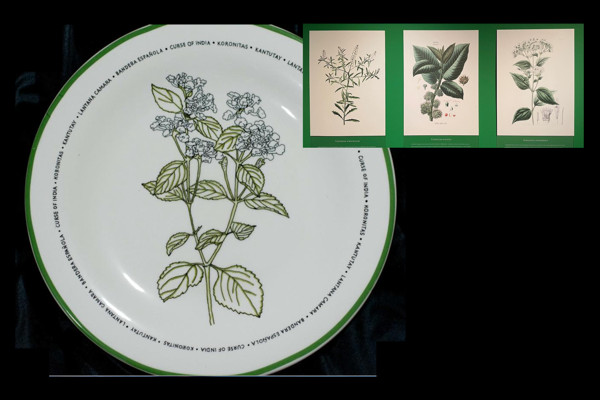The Ateneo Art Gallery presents Print(Ed): The AAG Print Collection Revisited at the Wilson L Sy Prints and Drawings Gallery, 2F/ Areté, Ateneo de Manila University. It runs until 14 September 2019. Admission is free.
Curated by Virgilio Aviado, the exhibit is divided into four sections of relief, intaglio, planography, and serigraphy— all basic printmaking techniques — and its variations such as woodcut, etching, engraving, mezzotint, linocut, collograph, and giclee. It includes some experimental and hybrid techniques used by contemporary artists. It also shows the tools, plates, and other materials used to create the prints, accompanied by extensive explanatory wall texts.
Take Your Time
Gaze carefully at each print, observe the printmaking method used, read the wall text, and imagine…
The exhibition shows a wide range of prints made by some 50 artists, both foreign and Filipinos. It starts with Spanish painter Francisco Goya (1746-1826) and one of the most masterful printmaker in history. His three etchings, all dark and enigmatic, are from Los Proverbios or Los Disparates (The Follies), his last print series done between 1815-1824. Other prints done by Honoré Daumier, Eugène Delacroix, Rembrandt, Salvador Dali, Käthe Kollwitz, Henri de Toulouse-Lautrec, and many more are on display, allowing the viewer to have a comparative perspective on the state of fine prints from all over the world.
Learning From the Best
To learn from the best is the mantra of the exhibit. Prints from the country’s finest artists are on display: Manuel Rodriguez, Sr, Benjamin Torrado Cabrera, Fil Delacruz, Vicente Manansala, Anita Magsaysay-Ho, Manuel Baldemor, Ofelia Gelvezon-Tequi, Lito Mayo, Rod Paras-Perez, Cenon Rivera, Juvenal Sanso, Arturo Luz, Bencab, Fernando Zobel, and the list goes on.
One of the country’s leading printmakers who specializes in engraving is Benjamin Torrado Cabrera who is known for his intricate images inspired by his interest in cosmology. He uses acrylic sheets for intaglio and relief prints. In Female Essence, A/P, 2006, a woman stands amidst darkness with her mind ablaze, illuminating an underwater world filled with tiny fishes and bubbles. A fine arts graduate of the University of Santo Tomas, Cabrera studied engraving at the Atelier Contre Pointe, Paris. Today, he teaches at the fine arts program of St. Scholastica’s College, Manila.
Fil Delacruz (b. 1950) shows his delicate prowess in controlling the line as well as the fine gradations between black and white as seen in his three works: a lithograph, Dilim at Liwanag, 4/18, 2000 that references his Diwata series known for its imagery of Mindanao’s ethnic groups, inspired by Gunsal Malayo, a young B’laan woman in Sultan Kudarat, Cotobato in the 1970s. And two mezzotints, namely, Transmogrification, A/P, 1982 with its superimposed layers of blue and green landscape that depicts one of the Horsemen of Apocalypse; the blackened part shows lush flora and fauna of beetles, horses, reptiles, and a dragonfly. Is it a dying landscape? And in Logger’s Haven, A/P VI, 2000, rows of cut trees are seen, signifying denuded forests, illegal logging, and man’s greed, plain and simple.
Delacruz is a graduate of fine arts, University of Santo Tomas, and a Thirteen Artists (CCP) awardee in 1992 as well as a former president of the Association of Pinoy Printmakers.
Manuel Rodriguez Sr. (1912-2017), the Father of Philippine Printmaking, has two woodcuts, namely, Circus Horses, 1950, Mother and Child, 1957, and a copper etching plate of his Fluvial Procession, 1960. He initiated the establishment of the Philippine Association of Printmakers in 1968, now known as the Association of Pinoy Printmakers, which continues to promote the art of the fine print through exhibitions and workshops.
Getting It Just Right
By presenting a selective number of prints that shows the range and breadth of its collection, AAG has offered a learning space in understanding the whats and the hows of printmaking. The advent of new media and digital technology has widened further the possibilities of traditional printmaking.
Printmaking is laborious and fraught with challenges. It requires attention to its processes and materials. In painting, one can see directly the image on the canvas. In contrast, printmaking involves several processes. The first step is to cut, carve, scratch, or incise a design into wood, metal, linoleum, rubber, plastic, or stone. Acids are also used to etch a design. The second step is to coat the plate with ink, and press unto paper where the inked design is transferred. When using colors, each color is applied to the plate and transferred separately to the paper. At any point, anything could go wrong and ruin the work: uneven or patchy ink transfer, inaccurate color placement, smeared ink, or dark or white lines on the print.
Many of the prints were donated by Fernando Zobel (1920-1984) whose initial bequest of some 200 art works to Ateneo in 1960 paved the way for the birth of the Ateneo Art Gallery, the first museum of modern art in the country.





